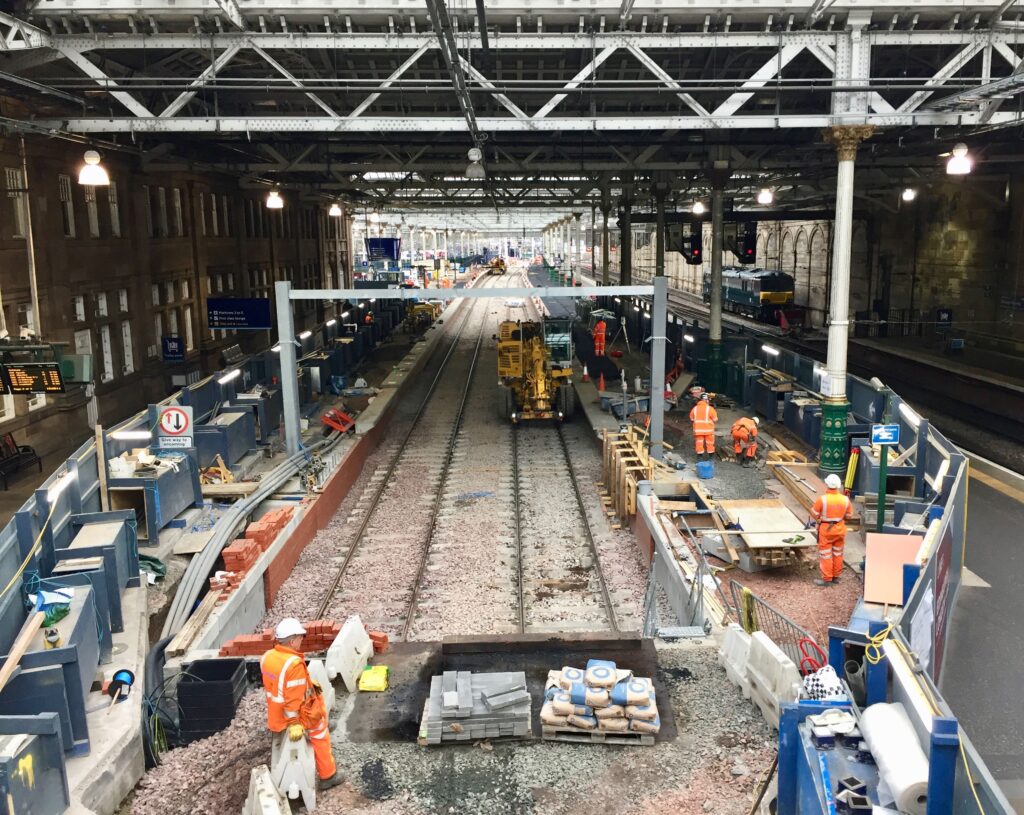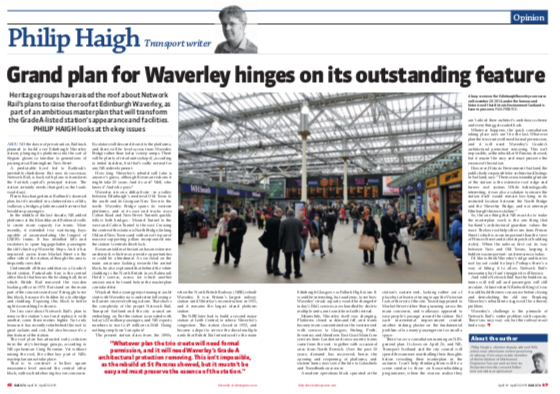Around the dawn of privatisation, Railtrack planned to build over Edinburgh Waverley station, to plunge its platforms into a stygian gloom so familiar to generations of passengers at Birmingham New Street.
A predictable howl prompted Railtrack’s inevitable climbdown but now its successor, Network Rail, is back with plans to transform the Scottish capital’s principal station. It needs it.
Plenty has changed since Railtrack’s doomed plan but it’s resulted in a cluttered mix of lifts, walkways, bridges, platforms and barriers that bewilders passengers. In the middle of the last decade, NR added platforms at the Klondike and Balmoral walls to create more capacity for trains. More recently it extended two east-facing bays for LNER’s longest trains. And it’s installed lifts and escalators to spare luggage-laden passengers the stiff climb up Waverley Steps. It’s improved access from Market Street on the other side of the station, although this area is frequently crowded.

Under all these additions is a Grade-A listed station. The central office block is particularly fine. But stand on the main part of the concourse and you’ll struggle to see this block because it’s hidden by a footbridge and cladding. I welcome better exposure of this block.
Waverley ambition
I’m less sure about Network Rail’s plan to remove the station’s roof and replace it with another some three metres higher. Not only because NR recently refurbished this roof to great acclaim and cost but also because it’s a fine feature of the station.
City heritage groups are critical of NR’s roof plan, according to NR spokesman Craig Bowman. Yet without raising the roof, NR cannot implement the other key part of its masterplan. That part is to build a hollow square mezzanine level around the central office block with each side its own concourse. Escalators will descend to the platforms. There will be level access from Waverley Bridge rather than today’s steep ramps. They’ll be plenty of retail units – shops! – according to initial sketches but that’s sadly normal for any NR redevelopment.
How long Waverley’s rebuild will take is anyone’s guess, although Bowman reckoned it might take 30 years, and its cost – well, who knows? And who pays?
Sitting in the centre
Waverley sits on a difficult site. It’s in a valley between Edinburgh’s medieval Old Town and its Georgian New Town. Waverley Bridges spans its western platforms and at its east end, it tracks cross Calton Road and New Street. Tunnels quickly follow both bridges – Mound Tunnel to the west and Calton Tunnel to the east. Crossing the centre of the station is North Bridge, linking Old and New Towns and with one of its pair of its massive supporting pillars incorporated into the station’s central office block.
Craig Bowman told me the station has an extensive undercroft, which may provide opportunities or be a hindrance. As we stood on the main concourse looking towards the central block, he explained that behind the white cladding is the North British (now Balmoral) Hotel’s service access. NR must find an alternative before it can implement its masterplan.
We joked that a young project manager could start with Waverley now and retire following a full career once everything is done. That shows its complexity. But the station is crowded. Today it has 23 million passengers; NR expects this to be 49 million in 2048. Doing nothing simply isn’t an option!
Still Britain’s largest
The present station dates from the 1890s when the North British Railway rebuilt Waverley. It was Britain’s largest railway station until Waterloo’s reconstruction in 1921 and it remains the largest island platform station.
The NBR later built a second major station at Leith Central to relieve Waverley’s congestion. British Rail closed Leith in 1952 and converted it to become a depot to service the DMUs plying the main Edinburgh-Glasgow route.
Meanwhile, Waverley was changing. BR closed platforms as demand fell and it concentrated trains on the western end with services to Glasgow, Stirling, Perth, Inverness and Aberdeen. East Coast Main Line services from London, and cross-country trains, came from the east together with occasional ones from North Berwick. Over the last 20 years, demand has recovered, hence NR opening and reopening platforms. The line to Galashiels and Tweedbank added more trains into Waverley’s eastern end.
The railway built a modern operations block. It looked rather out of place but at least did not ape Waverley’s Victorian look. Taxis disappeared to Market Street rather than queueing across the main concourse and walkways appeared to ease peoples’ passage around the station. Each incremental improvement created another sticking plaster on the fundamental problem of too many passengers in too small a space.
Whatever happens, the quick consultation taking place now can’t be the last. Whatever plan NR, TS and the city council create, it will need formal permission and it will need Waverley’s Grade-A architectural protection removing. This isn’t impossible as the rebuild at St Pancras showed but it mustn’t be easy and must preserve the essence of the station.
It’s all about the roof at Waverley
However, Historic Environment Scotland, the public body responsible for architectural listings in Scotland says: “The most outstanding feature of the station is the extensive roof ridge and furrow roof system. While technologically interesting, it was also a solution to ensure the station itself would remain low-lying in its restricted location between the North Bridge and the Waverley Bridge and not interrupt Edinburgh’s historic skyline.”
So the one thing that NR must do to make the masterplan work is the one thing that Scotland’s architectural guardian values the most. The low roof helps the view from Princes Street. When the railway first cut its way between New and Old Towns, keeping it hidden was important and remains so today.
I hope NR keeps Waverley’s ridge and furrow roof layout. Perhaps there’s a way of lifting it to allow Network Rail’s mezzanine but I can’t imagine it will be easy. And while Network Rail has the builders in, trains will still call and passengers will still circulate. At least when NR rebuilt King’s Cross it could build the new concourse before closing and demolishing the old one. Breaking Waverley’s rebuild into stages will be a thorny problem.
Waverley’s challenge is the pinnacle of Network Rail’s wider problem with capacity. There’s no easy way out but the railway must find a way.
The article was first published in RAIL 876 on April 10 2019.
